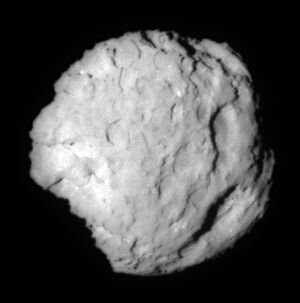| 81P/Wild | |
|---|---|
 | |
|
Location in Solar System |
Orbiting in the inner to outer regions of the Solar System |
|
Discoverer |
Paul Wild |
|
Date of Discovery |
January 6, 1978 |
|
Place of Discovery |
Zimmerwald |
|
Known satellites |
None |
81P/Wild, more commonly referred to as Wild 2, is a short-period comet, meaning it only appears for a short period of time before returning. It was discovered Paul Wild on January 6, 1978 on January 6, 1978 in Zimmerwald, Switzerland. The nucleus, when observed, is believed to be approximately four miles in diameter.
Formation[]
Wild 2 is believed to be a solar remnant from the outer regions of the Oort cloud. When it made several collisions with other celestial bodies in this region, it was pushed into a different region of the Oort Cloud, and soon traveled into the inner regions of the Solar System. Once the nucleus, or "heart" of the comet, became visible from Earth, it was designated as a short-period comet.
Exploration[]
In January 1994, NASA's Stardust mission flew by Wild 2. This space probe captured dust from its nucleus. It also collected particles from its coma when it came close enough to the Sun. Stardust photographed more than seventy photos of Wild 2, even being able to capture the jet plumes emitting from the nucleus. Jet plumes are the emitted rock and debris from a comet's nucleus.
Presence of liquid water was discovered on Wild 2 from evidence found from scientists at the University of Arizona in April of 2011. Minerals that primarily form from the presence of water have been discovered such as copper sulfide. Though comets are never believed to become hot enough to melt their icy bulks, it is believed another solar heating source caused the necessary heating requirements.
Observance from Earth[]
Wild 2 is a short-period comet, which means that it can only be seen for a small amount of time every few years. In fact, its next perihelion, or the closest distance a celestial body is from Earth or the Sun, will not reoccur until July 20, 2016. This means the nucleus is at its furthest distance from the Sun and does not have a coma around it at this moment.